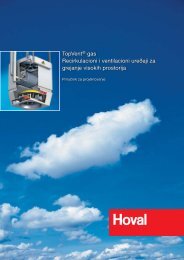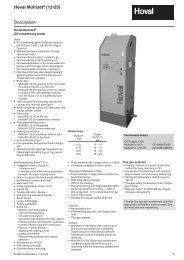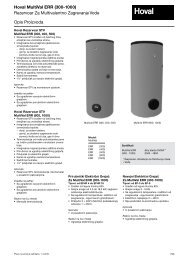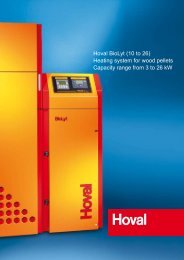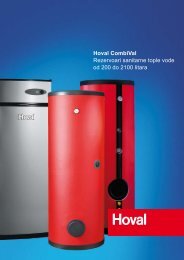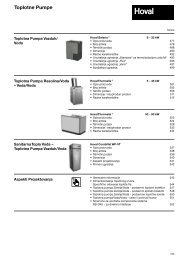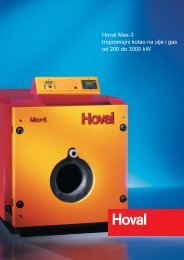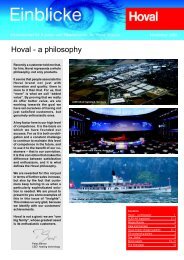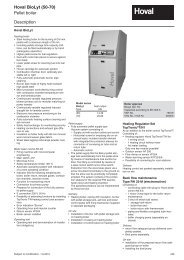Plate Heat Exchangers - Hoval
Plate Heat Exchangers - Hoval
Plate Heat Exchangers - Hoval
You also want an ePaper? Increase the reach of your titles
YUMPU automatically turns print PDFs into web optimized ePapers that Google loves.
Contents1 Principle and Operation_________41.1 <strong>Heat</strong> transmission1.2 Leakage1.3 Moisture transmission1.4 Condensation1.5 Temperature profile1.6 Frost limit1.7 <strong>Heat</strong> recovery efficiency1.8 Pressure drop1.9 Pressure difference1.10 Hygiene2 Performance Control___________83 Construction__________________93.1 Exchanger package in design S3.2 Exchanger package in designs F and P3.3 <strong>Plate</strong> connection3.4 Casing of designs S and F3.5 Casing of design P4 Model Range________________ 114.1 Designs4.2 Series4.3 Exchanger sizes4.4 <strong>Plate</strong> spacing4.5 Exchanger width5 Options____________________145.1 Bypass B5.2 Control dampers K5.3 Recirculation bypass U5.4 Leakage test P5.5 Stronger packing Q5.6 Horizontal installation L5.7 Adapter H for actuator9 Design Guidelines____________289.1 Selection program <strong>Hoval</strong> CAPS9.2 Design data9.3 Rules and guidelines9.4 Positioning of unit and system layout9.5 Cost-effective design9.6 Twin exchangers9.7 Performance control9.8 Recirculation bypass9.9 Sound attenuation9.10 Corrosion9.11 Application limits9.12 Dirt build-up9.13 Condensation in the warm air stream9.14 Solvent resistance9.15 Operation and function reliability10 Transport and Installation_____3110.1 Transport10.2 Mechanical installation10.3 Damper drive10.4 Condensate drain connection10.5 Fitting of sensors and other detectors10.6 Assembly on site11 Commissioning andMaintenance_______________3211.1 Commissioning11.2 Maintenance12 Specification Text____________3312.1 Designs S and F12.2 Design P6 Application Limits,Specification of Material________196.1 Application limits6.2 Specification of Material7 Unit Type Reference__________218 Exchanger Dimensions________21<strong>Hoval</strong> <strong>Plate</strong> <strong>Heat</strong> <strong>Exchangers</strong>Handbook for Design, Installation and OperationSubject to technical alterations.Art.Nr. 4 209 956 – 09 / 2010© <strong>Hoval</strong> AG, Liechtenstein, 20101
At a GlanceAt a Glance<strong>Heat</strong> recovery reduces costs andprotects the environment<strong>Hoval</strong> plate heat exchangers are important elementsin saving energy in industrial and commercialbuildings such as hotels, hospitals, sportshalls, office buildings, seminar rooms, swimmingpools, drying pro cesses, paint spray booths andextraction plants. They are used in air handlingunits, duct work systems and in process technology.This investment pays off in several ways:■■Lower energy consumption■■Lower investment for heat generation anddistribution■■Less damage to the environmentThree designs<strong>Hoval</strong> manufactures 3 designs to satisfy the technicaldemands on the exchanger package (dimensions,plate spacing, rigidity). The design selectiondepends on the air flowrate and the application.■■Design SFor 'normal' applications in air handling installationswith air flowrates up to about 50 000 m³/h.No cross-contamination of the air streamsIn the <strong>Hoval</strong> plate heat exchanger the warmextract air and the cool fresh air, separated by thinplates, pass each other in cross-flow. No mixingof the two air streams takes place. Therefore, thetransmission of dirt, odours, moisture, bacteria,etc. is impossible. <strong>Heat</strong> is transmitted from extractair to fresh air purely by conduction as a result ofthe temperature difference between the two airstreams: The warm extract air is cooled down; thecool fresh air is heated up.■■Design FFor applications in process technology and inair handling installations with air flow rates up to100 000 m³/h.Wide variety of sizes available<strong>Hoval</strong> plate heat exchangers are available in awide range of sizes to suit every application:■■Exchanger lengths from 0.4 to 2.4 metres■■Packages from 0.2 to 3.0 metres wide■■Air flowrates from 500 to 100 000 m³/hThe individual exchanger packages can be suppliedwith different plate spacings and heat recoveryefficiencies.■■Design PIn stainless steel for applications in processtechnology.2
Principle and OperationPrinciple and Operation1 Principle and Operation<strong>Hoval</strong> plate heat exchangers operate within the guidelines forheat recovery (e.g. Eurovent 10, VDI 2071) as recuperatorswith joint faces (category 1). The heat releasing and heatabsorbing air streams pass along the joint face, throughwhich the heat is directly transmitted. Supply and extract airmust therefore be brought together and flow through the heatexchanger.Fig. 1: The air streams,separated by thin plates,pass each other.1.1 <strong>Heat</strong> transmission<strong>Hoval</strong> plate heat exchangers operate on the cross-flow principle.<strong>Heat</strong> is transmitted via the plates from the warm to thecold air stream. A much simplified performance calculation is:Q = k · A · ΔtWhen temperatures are given, the transmitted heat performanceis assumed by design characteristics.<strong>Heat</strong> transfer rateThe k-value is calculated from the thickness and heat conductivityof the plates, as well as heat transfer on both sides:1 1 d 1⎯ = ⎯ + ⎯ + ⎯k α 1 λ α 2As thin plates are used, for cost reasons, the influence of thematerial can be neglected. This is shown in table 1:MaterialThickness[mm]λ[W/mK]α 1 = α 2[W/m²K]k[W/m²K]Aluminium 0.125 200 40 19.9998Aluminium 0.250 200 40 19.9995Stainless steel 0.125 15 40 19.9967Plastic 0.250 0.2 40 19.5122Table 1: <strong>Plate</strong> thickness and material have only a slight effect on the efficiency.1.2 LeakageComponents of air handling units, for example dampers,ducts or casings, are not normally 100 % leakproof. Thisis mainly because it is not necessary to ensure the correctfunction and it would be very expensive. In practical use,however, leakage must not exceed technically justifiable limits.Therefore, test specifications and limits (EN 1751) existfor certain components, such as dampers. For heat recoveryunits, there is no such data at the moment. Nevertheless,actual values are known from tests.A difference has to be made between the following:■■Leakage to outside (external)■■Leakage between supply and extract air (internal)While sealing to outside normally does not cause anyproblems (it is above all a question of assembly quality),the internal leakage mainly depends on the system andexchanger construction. As an approximate value for theinternal leakage of <strong>Hoval</strong> plate heat exchangers a maximumof 0.1 % of the nominal air flowrate can be used (at 250 Papressure difference).The leak tightness of <strong>Hoval</strong> plate heat exchangers is farbetter than other manufacturers' data. Nevertheless, it mustbe noted that exchangers are not 100 % leakproof unlessspecial measures are taken.For good heat transmission, the heat transfer α must be highon both sides of the plates. For this reason <strong>Hoval</strong> optimisedthe plate profiles with extensive testing resulting in high efficiencyrelatively independent of the flow velocity.Exchanger surface areaThe amount of heat transmitted is directly dependent onthe exchanger surface area. With the number of plates andtheir spacing, the efficiency is easily changed, optimised orselected to meet a particular specification. Therefore differentplate spacings are available for most types of <strong>Hoval</strong> plateheat exchangers. The optimum economic exchanger can beselected for a specific project.4
Principle and OperationPrinciple and Operation1.3 Moisture transmissionThe two air streams are separated in the <strong>Hoval</strong> plate heatexchanger and transmission of moisture is therefore notpossible. This is a special advantage when moisture isremoved with the warm air, e.g. in swimming pools, dryingprocesses, etc.1.4 Condensation<strong>Hoval</strong> plate heat exchangers do not transmit moisture butstill can use part of the latent heat of moist extract air. At lowoutside temperatures, when there is a high heat demand, theextract air is cooled down to such a degree that the saturationtemperature is reached and condensation is formed.Thus the latent heat of evaporation is released. This reducesfurther cooling of the extract air, i.e. the temperature differencebetween the air streams in the plate heat exchangeris greater than when there is no condensation. Also theheat transfer is better; consequently the efficiency is raisedsignificantly. This can be seen clearly in the hx diagram. Thecold air stream is heated more than the warm air is cooled.Nonetheless the enthalpy difference is the same, assumingequal water content.Condensation in the extract air reduces the free area of theairway and is responsible for an increase in pressure drop.Therefore it is important that the condensation can drainaway. This depends mainly on the fitting position of theheat exchangers and on the form of the plates. <strong>Hoval</strong> plateheat exchangers offer advantages because of their specialprofiles.If condensation occurs the internal and external leakageof the exchanger is of particular importance. Even with aleakage rate of only a maximum of 0.1 % of the nominal airflowrate – as with the <strong>Hoval</strong> plate heat exchanger – up to3 litres condensate an hour can leak out, even more in extremecases. The absolute value depends on the size of theexchanger, the number of plates, the amount of condensateand the pressure difference.t 2ht 11.5 Temperature profileWith the cross-flow heat exchanger, the air streams are notheated and cooled evenly. This means that the temperaturesvary along the cross section of the air stream. The computergraphic, calculated by the finite element method, shows this.Because of the temperature variation the verification of theefficiency under operating conditions is practically impossible.For this reason, the performance of representative<strong>Hoval</strong> plate heat exchangers has been empirically tested,measured and agreed by independent test institutes – tosafeguard the consultant, installer and operator.t [°C]302520151050-5-10-15-20t 12t 21t 22t 11t [°C]302520151050-5-10-15-20hFig. 2: Changes of condition in the hx diagramFig. 3: Temperature profile of the air streams5
Principle and OperationPrinciple and Operationconsidered when designing:■■The pressure difference in the heat exchanger should bekept to a minimum.■■The pressure gradient and thus leakage should be fromthe supply air to the extract air side.The internal pressure difference also may cause a deformationof the plates. The plate spacing is then narrowed and/or widened, resulting in corresponding variations of pressuredrop. Extensive tests have shown that the influence of deformationdepends on the plate spacing (see diagram 1).The permitted pressure difference between the two airstreams is limited to:■■2500 Pa for design S■■2000 Pa for designs F and PThis is geared to the still acceptable pressure drop increase;a permanent deformation does not occur. The expected pressuredrop increase depending on the exchanger type and theexisting internal pressure difference can be calculated withthe selection program <strong>Hoval</strong> CAPS.1.10 Hygiene<strong>Hoval</strong> plate heat exchangers were subjected to hygieneconformity testing at the ILH Berlin (institution of air hygiene).Test criteria were the hygiene-relevant requirements for applicationsin general air conditioning systems and in hospitals.All hygienic requirements were met.NoticeThe pressure difference depends on the position offans. Overpressure on one side and underpressureon the other side add up.Fig. 5: Certificate of hygiene conformity test5045Pressure drop increase in %at a pressure difference of:4035302520151052500 Pa2000 Pa1500 Pa1000 Pa500 Pa01 2 3 4 5 6 7 8 9<strong>Plate</strong> spacing in mmDiagram 1: Pressure drop increase due to internal pressure difference forexchangers design S7
Performance ControlPerformance Control2 Performance ControlThe <strong>Hoval</strong> plate heat exchanger operates as a temperaturemoderator between the two air streams. The direction of theheat transmission is of no consequence, i.e. depending onthe temperature difference between extract and fresh air,either heat recovery or cool recovery takes place. Thereforeperformance control of the <strong>Hoval</strong> plate heat exchanger is notnecessary when the extract air temperature is identical to thedesired room temperature. In this case, the outside temperatureis always either heated or cooled through the plate heatexchanger in the direction of the set temperature.In many cases, however, heat gains are present in theventilated space (people, machinery, lighting, solar, processplants), which increase the room temperature, so that theextract air temperature is higher than the set temperature. Inthis case, at full performance of the heat exchanger, check atwhich outside temperature heat-up begins, and if this cannotbe tolerated, the performance of the heat exchanger must becontrolled.ExampleIn an industrial building the room air is heated from 18 °Cto 24 °C through lighting and machinery. The heat recoveryfigure Φ 2 is 66 %. At which outside temperature t 21 isthe space heated only by heat recovery without additionalheating?t 21t 22 − (Φ 2 · t 11 )= ⎯⎯⎯⎯⎯⎯⎯(1 − Φ 2)18 − (0.66 · 24)t 21= ⎯⎯⎯⎯⎯⎯⎯ = 6 °C(1 − 0.66)Fig. 6: The bypass is most effective for the control of performance.There are two options for the fitting of the bypass:Bypass in the fresh air:Depending on damper position, between 0 % and 100 %of the fresh air passes through the bypass. The extract airalways flows through the heat exchanger and is cooled accordingto the fresh air flowrate. With this arrangement thecooling of the extract air and thus freezing can be avoided.Bypass in the extract air:Between 0 % and 100 % of the extract air passes throughthe bypass. The fresh air always passes through the plateheat exchanger. This arrangement is recommended whenthe extract air is very dirty, as during summer operation theextract air does not pass through the plate heat exchanger.At higher outside temperatures the hall is heated above thedesired room temperature, this means the performance ofheat recovery should be controlled.With the <strong>Hoval</strong> plate heat exchanger the performance controlthrough change of the mass flow ratio is simply and economicallyaccomplished with the bypass. All <strong>Hoval</strong> plate heatexchangers can therefore be supplied with integral bypassand control dampers. Exchanger and bypass width are automaticallyselected using the computer program in such a waythat pressure drop is equal. Whether a bypass is fitted on theside or in the middle depends on local conditions and on thewidth of the exchanger. The arrangement of further ventilationcomponents after the bypass, e.g. air heater, moistureeliminator, etc., must take into consideration the fact that thevelocity profile can be uneven.8
ConstructionConstruction3 Construction<strong>Hoval</strong> plate heat exchangers consist of the exchanger packageand the casing. Sizing of the exchanger package (platesize and plate spacing) depends mainly on the air flowrate.To achieve an optimum result with regard to heat recoveryefficiency, pressure drop and costs <strong>Hoval</strong> manufactures differentpackage designs:■■design S with plate spacings from 2 mm to 9 mm■■designs F and P with plate spacings from 4 mm to 12 mm3.1 Exchanger package in design SThe exchanger package consist of specially formed aluminiumplates. Their profile with V-shaped spacing ribs isan optimum design resulting from detailed tests for heatrecovery efficiency, pressure drop and rigidity. The mainadvantages are:■■Little dependency of the heat recovery efficiency on theair velocity■■Exact spacing between the plates through positive/negativestamping■■High rigidity of the thin aluminium plates through the specialarrangement of the vertical and horizontal ribs■■The profiles are arranged in such a way that the condensationcan drain in every direction.■■Uneven flow patterns can even out inside the heatexchanger.There are 7 different plate sizes, which are formed with differentprofile depths, i.e. for different plate spacings. Thus agreat variety of different exchanger packages can be made,independent of width.3.2 Exchanger package in designs F and PThe exchanger package consists of specially shaped aluminiumor stainless steel plates. Their profile with V-shapedspacing ribs is an optimum design resulting from detailedtests for heat recovery efficiency, pressure drop and rigidity.The main advantages are:■■Little dependency of the heat recovery efficiency on theair velocity■■Exact spacing between the plates■■High rigidity through crosswise stacking of the spacingribs■■Excellent flow profile at exchanger inlet■■Condensate can drain freely in all directionsThere are 4 different plate sizes for package design F and2 different plate sizes for packaged design P. Thus a greatvariety of different exchanger packages can be made, independentof width.3.3 <strong>Plate</strong> connectionThe connection of the plates is made by a fold. This givesa severalfold material thickness for the leading and trailingedges, which gives good rigidity to the exchanger package.Also a streamlined flow profile is given, which reduces notonly pressure drop but also the possibility of dirt deposits.Fig. 7: The special profiles of <strong>Hoval</strong> plates are the resultof extensive tests and measurements (design S shownhere).Fig. 8: Thanks to folded plate connections theexchanger packages are tight and rigid (design F shownhere).Fig. 9: Folded connections give the exchanger packageseveralfold material thickness for the leading andtrailing edges (design S shown here).9
ConstructionConstruction3.4 Casing of designs S and FThe exchanger package is fitted into a casing of cornersections and side walls. The specially developed aluminiumsections offer many advantages:■■The corners of the exchanger package are sealed into thesections with a sealing compound. This technique ensuresoptimum integration of the package into the casing.■■Other components can be bolted or riveted directly tothe hollow sections without affecting the rigidity of theexchanger or damaging the exchanger package.■■At the corners the sections are flattened by 45°, whichfacilitates installation of the plate heat exchanger andreduces the diagonal dimension.The side walls are bolted to the corner sections. This createsflat surfaces for connecting ducts or other components.In addition, the returned edge of the side wall allows easyinstallation of a side sealing all round, facilitating integrationinto a casing.3.5 Casing of design PThe side walls and corner sections are made of stainlesssteel. The following are the important differences comparedwith designs S and F:■■The corners of the stainless steel exchanger package aresealed in the corner sections with a PU adhesive.■■The corner section is larger and open, which facilitatesinstallation.■■The side walls are welded.Fig. 13: For exchangers in design P thecorner section is larger and open.Fig. 14: The corners of the stainlesssteel exchanger package are sealed inthe corner sections with a PU adhesive.Fig. 10: The specially developedaluminium sections offer manyadvantages.Fig. 11: A side sealing can be fastenedto the returned edge of the side wall.The side walls of all compound plate heat exchangers have aspecial profile for a sealing bead. This together with the sealingbead in the corner section ensures tight connection of theindividual exchanger blocks.Fig. 12: Thecircumferential sealingbead in the frame ofeach exchanger blockensures tight connectionof compound exchangers(here a cut-away model).Fig. 15: For speciallycorrosive atmospheresheat exchangers withplates in stainless steelcan be supplied.10
Model RangeModel Range4.5 Exchanger widthThe width of <strong>Hoval</strong> plate heat exchangers can be as desired.It can be selected according to local conditions and designcriteria (e.g. pressure drop). For stability reasons the maximumexchanger width is limited to 3000 mm.In order to simplify transport and installation, very wideexchangers of design S are delivered in 2 parts. This appliesfor the following exchanger sizes:Exchanger size Partitioned design for:S-040 to S-060 Width > 1400 mmS-070 to S-240 Width > 2050 mmTable 4: Partitioned delivery for design SSeveral exchangers with dampers are linked with connectingbolts when installed into the air handling unit so that onesingle actuator is sufficient. For this purpose, one or moreconnecting bolts are provided, depending on the exchangersize.Fig. 16: Damper connection for partitioned exchangers25 25Fig. 17: Detail of connecting bolt13
OptionsOptions5 Options5.1 Bypass BIf performance control of the plate heat exchanger is necessary,a bypass is built into the casing besides the plate package.This can be on the side or in the middle. The minimumwidth is 50 mm.NoticeTo ensure good flow conditions, installation in themiddle is strongly recommended for total widths of1500 mm and more.Dampers can be fitted directly to the flanges of the casing, infront of the exchanger face and bypass.The width of the bypass is automatically calculated with the<strong>Hoval</strong> computer selection program CAPS in such a way thatthe bypass has approximately the same pressure drop asthe exchanger package. However, the width of the bypasscan also be made to specification. The pressure drop to beexpected can be calculated with the <strong>Hoval</strong> computer selectionprogram.AttentionIn bigger exchangers reinforcing bar spacers are fittedin the bypass; do not use these spacers for liftingthe exchanger!5.2 Control dampers KTo regulate the air flow through the bypass or the exchanger,opposed control dampers are necessary. These are fittedby <strong>Hoval</strong> in a frame which is fastened directly on the casing,before the exchanger package and the bypass (seen in thedirection of air flow). The dampers have the following specialfeatures:■■The damper's air leakage flow rate complies with class 2,BS EN 1751.■■The driving plastic gear wheels are fitted in the middle, i.e.between the bypass and the heat exchanger.■■The gear wheels are fitted behind a flange and thus protectedfrom the air stream.■■The damper blades are made of galvanised sheet steel;therefore they are particularly rigid and tight.■■Each damper blade can be removed and replacedindividually.■■The maximum torque allowed is 20 Nm.■■The damper shaft (9.8 x 9.8 mm ) can be installed at anyblade on either side of the damper. To ensure an optimumtorque transfer installation at a blade in the middle of thedamper is recommended.■■For sizes 200 and 240 one damper section is fitted in frontof each exchanger package; therefore, two damper drivesare required.■■The maximum blade width is 1200 mm; with bigger dimensionsinterim bearings are installed.The bypass dampers have a free action if the plate heatexchanger is installed correctly (square). Extensive measurementshave shown that the necessary torque depends firstand foremost on the width.Diagram 2 shows the required torque as a function of theexchanger width, assuming proper installation.161412Torque [Nm]10864Fig. 18: Bypass built-in at the side or in the middle.200 500 1000 1500 2000 2500 3000Exchanger width [mm]Diagram 2: Necessary torque for the bypass damper (the values apply up to apressure difference of 500 Pa. )The dampers allow continuous control of the heat recoveryefficiency, as tests in the Testing Laboratory for BuildingTechnology of the Lucerne University have confirmed.14
OptionsOptions5.3 Recirculation bypass UA bypass with bypass damper (opposed dampers in front ofthe bypass and exchanger face) is installed in the plate heatexchanger. One side wall of the bypass damper is replacedby the additional recirculation damper. This arrangement iscalled recirculation bypass.The width of the recirculation bypass is either made to specificationor it is calculated with the computer program so thatpressure drop through the bypass roughly corresponds topressure drop through the exchanger package.The construction of the recirculation damper is the sameas the bypass damper. This applies to materials as well asdimensions. The recirculation bypass installed in the plateheat exchanger allows for:■■Control of heat/cool recovery in fresh air operation■■Recirculation and mixed air operating modesControl is effected via the bypass damper by means of anactuator. The recirculation damper must be opposed to thefresh air and exhaust air dampers. For this, at least onefurther actuator is required. The damper shaft (9.8 x 9.8 mm)can be installed at any blade on either side of the damper.Recirculation damperFig. 20: <strong>Plate</strong> heat exchanger with side recirculation bypassBypass damperNoticeUnless otherwise expressly requested, the positionof the recirculation damper is as shown in Fig. 20(default position).Bypass in the fresh airBypass in the extract airExtract airFresh airExtract airBypass damperFresh airRecirculation damperBypass damperRecirculation damperSupply airExhaust airSupply airExhaust air■■Fresh air operation: The recirculation damper is closed;fresh air and exhaust air dampers are open. The bypassdamper is used for control of heat recovery, dependingon heat demand.■■Recirculation: The recirculation damper is open; fresh airand exhaust air dampers are closed. (The position of thebypass damper can be as desired.) Extract air passesthrough the bypass of the plate heat exchanger and issupplied back into the room.■■Mixed air operation: Recirculation, fresh air and exhaustair dampers are partly open. The bypass damper is (usually)closed so that heat/cool recovery can be used to itsfull potential.■■Fresh air operation: The recirculation damper is closed;fresh air and exhaust air dampers are open. The bypassdamper is used for control of heat recovery, dependingon heat demand.■■Recirculation: The recirculation damper is open; fresh airand exhaust air dampers are closed. Extract air passesthrough the bypass of the plate heat exchanger and issupplied back into the room.AttentionThe bypass damper must be open!■■Mixed air operation: not possible16
OptionsOptions5.4 Leakage test PAs mentioned above (see section 1.2 and 1.4), plate heat exchangersare not 100 % leakproof unless special measuresare taken. Yet, by additional sealing <strong>Hoval</strong> can guaranteethat the exchanger is delivered watertight in the tested installationposition.Depending on requirements, the exchangers can be additionallysealed on two sides (2P = one air stream) or foursides (4P = both air streams).The leakage test is not available for exchangers of series T.Notice<strong>Exchangers</strong> for horizontal installation should alwaysbe checked on all 4 sides.5.5 Stronger packing Q<strong>Hoval</strong> plate heat exchangers are delivered on wooden pallets.The exchanger package is covered with multiply corrugatedcardboard. A wrapping gives additional protection fromdirt and moisture. This packing has proved to be sufficient fornormal transportation for many years.Stronger packing is available for cases where a 'harsh'transport is expected (e.g. sea freight): The exchanger withcorrugated cardboard is then strengthened on top with woodlaths and protection corners.5.6 Horizontal installation LNormally the <strong>Hoval</strong> plate heat exchanger is installed in sucha way that the plates are vertical. Horizontal installation isalso possible, considering the following:■■There is a higher icing-up hazard because condensatecan remain on the plates.■■Due to uncontrolled condensate drain a condensate driptry should be installed below the exchanger.■■Condensate drops can be carried along with the air flow;(drop eliminator recommended).■■A four-side leakage test is recommended.■■Install plate heat exchangers of designs F and P in such away that the spacing ribs stand upwards.■■To increase stability, supports are fitted in the exchangerpackage.■■Unless otherwise expressly requested, the side bypass ispositioned on top.NoticeFor horizontally installed exchangers the width Bin the unit type reference becomes the exchangerheight.Fig. 21: Spacing ribsstanding upwardsBFig. 22: Schematic viewof a plate heat exchangerinstalled in horizontalposition17
OptionsOptions5.7 Adapter H for actuatorUsing the adapter, <strong>Hoval</strong> dampers (bypass or recirculationdampers) can be driven inside a ventilation unit or duct withconventional rotary actuators. The maximum transmittabletorque is 20 Nm.The adapter is screw-fastened on the gear wheel housing.For this, the plate flange is cut out above a damper gearwheel so that the adapter gear wheel can be put on directly.The adapter is available in series V and G. To avoid damagein transit, it is supplied as a loose part with the exchanger. Itsweight is 0.6 kg.For installation take into consideration the following:■■The adapter is positioned above a damper gear wheelapproximately in the middle of the plate heat exchanger.■■Depending on the exchanger's installation position, it mustbe checked if there is enough space for the adapter.■■When installing the actuator ensure that the electriccables do not obstruct the damper motion.■■The adapter can also be retro-fitted on a plate heatexchanger.Fig. 24: Using the adapter <strong>Hoval</strong> dampers can be driven with conventional rotaryactuators.Design S 050 070 170Design F 100 120 140 160 200 24016021050Design S 040 060 085 100 120 140 200 240Design P 100 200Table 5: Adapter dimensions (in mm) and positioning on the damper with even or oddnumber of gear wheels18
Application Limits, Specification of MaterialApplication LimitsSpecification of Material6 Application Limits, Specification of Material6.1 Application limitsDesign Series Temperature Width PressuredifferencePressure differenceto outside°C mm Pa PaS V + G -40… 90max. 2500 max. 1500200…3000 1)T -40…200 max. 1000 max. 1000F V + G -40…100max. 2000 max. 1500200…3000 2)T -40…200 max. 1000 max. 1000P V -40…100max. 2000 max. 1500200…3000T -40…200 max. 2000 max. 1500Dampers V, G, T -40… 80 50…3000 3) max. 500 max. 1500Pressure dropPressure drop shouldnot exceed 250 Pa foreconomical reasons.Recommended:150 ... 200 Pa1)Partitioned delivery for widths > 1400 mm (S-040 to S-060) and > 2050 mm (S-070 to S-240)2)Partitioned delivery for widths > 2200 mm for F-140 and F-1603)Max. blade width = 1200 mm; with larger dampers interim bearings are installed.Table 6: Application limits for <strong>Hoval</strong> plate heat exchangersAttentionThe maximum temperature allowed for the dampersand the adapter H is 80 °C. In applications with highertemperatures the bypass damper must be positionedin the cold air stream; a recirculation damper is notallowed.19
Application Limits, Specification of MaterialApplication LimitsSpecification of Material6.2 Specification of MaterialSeries V G TDesign S / F P S / F S / F P<strong>Plate</strong> exchanger<strong>Plate</strong>s Aluminium Stainless steel AluminiumAluminium Stainless steelepoxy-coatedSide walls 1) Aluzinc sheet steel Stainless steel Aluzinc sheet steel, Aluzinc sheet Stainless steelpowder-coated red(RAL 3000)steelCorner sections Aluminium Stainless steel Aluzinc sheet steel,powder-coatedorange (RAL 2008)Aluminium Stainless steelSealingSilicone-free 2-component-adhesivePU adhesiveDampers and adapterCasing Aluzinc sheet steel Aluzinc sheet steel,powder-coated red(RAL 3000)Damper blades Galvanised sheetsteelBearing, end caps,gear wheels1)Except F-160: Sheet steel, powder-coated red (RAL 3000)Galvanised sheetsteel, powder-coatedorange (RAL 2008)Silicone-free 2-component-adhesiveAluzinc sheet steel,powder-coated red(RAL 3000)Galvanised sheetsteel, powder-coatedorange (RAL 2008)Polypropylene Polypropylene PolypropyleneHT siliconelike series VHT siliconeAttention: Dampers mustbe positioned in the cold airstream (max. 80 °C)!Table 7: Specification of material for <strong>Hoval</strong> plate heat exchangersNoticeAluzinc sheet steel is sheet steel coated with an alloyof 55 % aluminium and 45 % zinc.NoticeA hygiene certificate of ILH Berlin (institution of airhygiene) confirms the exchangers suitability for use ingeneral air handling systems as well as in hospitals.20
Unit Type ReferenceUnit Type Reference7 Unit Type Reference8 Exchanger Dimensions<strong>Hoval</strong> plate heat exchangers are clearly defined with the unittype reference. This shows all possibilities for design andoptions.The following drawings show various designs and exchangersizes. The dimensions given are those relevant for connectionof the plate heat exchanger. For clarity, details oftype sizes made up of four exchanger packages have beenomitted.Example of unit type referenceSV - 060 / X - 085 - BSK20, Q, ...DesignS = Design SF = Design FP = Design PSeriesV = StandardG = Corrosion-protectedT = High-temperatureSizeCode for the size of the exchanger plates<strong>Plate</strong> spacingminmaxC D R S X Y L WExchanger width in cm (outside dimension)Options2P = Leakage test on 2 sides4P = Leakage test on 4 sidesL = Horizontal installationH = Adapter for actuatorQ = Stronger packingB = Bypass (BS or BM)U = Recirculation bypass (US or UM)K = Dampers for exchanger with bypasse.g. BS K 25Inside bypass width in cmDampersBS = Side bypassBM = Middle bypassUS = Side recirculation bypassUM = Middle recirculation bypassFig. 23: Unit type reference for <strong>Hoval</strong> plate heat exchangers21
Exchanger DimensionsExchanger DimensionsDesign SExchanger size 040 050 060 070 085 100 120 140 170 200 240Height, length H = L 367 467 567 690 840 990 1190 1380 1680 1980 2380Diagonal D 506 648 789 963 1175 1387 1670 1939 2363 2787 3353AReinforcing sectiononly for S-200, S-240b = B - 50 (mm)B(S-040- S-060: max. 1400 mm)(S-070- S-240: max. 2050 mm)Detail AExchanger sizes: 040, 050, 060Detail AExchanger sizes: 070, 085, 100, 120, 140, 170, 200, 240H = L20H = L8.519.528.54637Damper contactsurfaceD5.512.7Damper contactsurface1212.7DTable 8: Dimensions of exchangers without bypass, design S (in mm)22
20Exchanger DimensionsExchanger DimensionsDesign FDetail AExchanger size 100 120 140 160 200 240 24Height, length H = L 968 1168 1387 1567 1936 2336Diagonal D 1349 1632 1942 2196 2718 32843650DHADL25b = B 50 (mm)B (max. 3000 mm)Table 9: Dimensions of exchangers without bypass, design F (in mm)23
47Exchanger DimensionsExchanger DimensionsDesign PDetail AExchanger size 100 200 41Height, length H = L 1002 2004Diagonal D 1417 28344275DAb = B - 100 (mm)B (max. 3000 mm)50Table 10: Dimensions of exchangers without bypass, design P (in mm)24
Design GuidelinesDesign Guidelines9 Design Guidelines9.1 Selection program <strong>Hoval</strong> CAPSThe design of <strong>Hoval</strong> plate heat exchangers is easy and quickwith the selection program <strong>Hoval</strong> CAPS (= Computer Aided<strong>Plate</strong> <strong>Heat</strong> Exchanger Selection). It runs under Microsoft ®Windows and offers the following:■■Reliable design data thanks to Eurovent-certified data■■Exact calculation of a specific <strong>Hoval</strong> plate heat exchanger■■Calculation of all appropriate plate heat exchangers for aspecific project■■Price calculationNoticeThe selection program <strong>Hoval</strong> CAPS is available fordownload on our homepage (www.hoval.com).9.2 Design dataWhen designing, correct data is essential to achieve thedesired values. This is often particularly difficult in air handlinginstallations because the specific density and specificheat are dependent on temperature. Also the water vapourcontained in the air is very important for the design. For anexact calculation of a plate heat exchanger the air conditionsat entry to the exchanger are required.Extract air Air flowrate at exchanger entry V 11 [m 3 /s]Rel. humidity at exchanger entry RH 11 [%]Temperature at exchanger entry t 11 [°C]Max. pressure drop Δp 1 [Pa]Fresh air Air flowrate at exchanger entry V 21 [m 3 /s]Temperature at exchanger entry t 21 [°C]Max. pressure drop Δp 2 [Pa]Table 14: Design data for plate heat exchangers (When cooling the data is reversed,i.e. swap extract air for fresh air – corresponding to 'heat releasing' and 'heatabsorbing'.)The following errors should be avoided when collecting thedata:■■Volume flow is not equal to mass flow. For an accuratedesign the mass flows of fresh and extract air should beknown.■■For winter operation the moisture in the air is often estimatedtoo high. (Where does the moisture come from?)■■Are the temperatures (fresh air, extract air) really as statedin practice (or are they wishful thinking)?For an economic calculation the following data is required:■■Desired temperature■■Operation time■■Location (region or climatic zone)■■Energy costs (with increase rate)■■Cost of electricity■■Additional costs (installation and extra costs minus capitalsavings and subsidies)■■Interest rate9.3 Rules and guidelinesAscertain before designing which rules and guidelinesapply. For instance, for some applications (e.g. hospitals)some heat recovery systems are not suitable or can only beallowed after appropriate proving. Furthermore EuropeanStandards (e.g. EN 13053) specifiy minimum requirementson heat recovery.Fig. 25: The design of <strong>Hoval</strong> plate heat exchangers is easy andquick with the selection program <strong>Hoval</strong> CAPS.28
Design GuidelinesDesign Guidelines9.4 Positioning of unit and system layout■■Where should the heat recovery unit be positioned?■■Which is the optimum air path?■■Which dimensions are allowed?These questions are important when selecting a plate heatexchanger and should be thoroughly examined in advance.Little general recommendation can be given for positioningand air path. Only take care that condensate, if present, candrain freely and does not remain inside the exchanger, thuscausing a higher pressure drop. This is always guaranteedwith a downward extract air flow. Yet, in practice all possibleairflows and positions are used without any problems.Section 5.6 gives special tips for horizontal installation.9.6 Twin exchangersIf a particularly high efficiency is required it is possible toconnect 2 or even more plate heat exchangers in series. Thetotal efficiency is calculated as follows:Φ 2A + Φ 2B − (1 + µ) ⋅ Φ 2A ⋅ Φ 2BΦ2total = ⎯⎯⎯⎯⎯⎯⎯⎯⎯⎯⎯⎯⎯⎯⎯⎯1 − µ ⋅ Φ 2A ⋅ Φ 2BVarious arrangements are possible; the important thing isthat the two air streams pass each other in cross flow.9.5 Cost-effective designSelect the most economical type, regarding efficiency and/orplate spacing. The following rules apply:■■Long periods of operation (e.g. 3 operating shifts)→ high efficiency■■Long life span of unit→ high efficiency■■High extract air humidity and thus improved efficiencythrough condensation→ medium, large or very large plate spacing■■High dirt hazard→ large or very large plate spacingWhen using plate heat exchangers in process technology,ascertain whether the heat recovery figure is limited due tosupply air temperature.The optimum plate heat exchanger selection can only bebased on an economic calculation.Fig. 26: Twin exchangers offer interesting connection possibilities and highest heatrecovery values.Fig. 27: For unequal mass flow rates check parallel flow or counter flow arrangements.9.7 Performance controlCheck which internal heat sources are available in the hall.If the extract air temperature is expected to be clearly higherthan the desired temperature, a performance control of theplate heat exchanger should be considered (see section 2).29
Design GuidelinesDesign Guidelines9.8 Recirculation bypassIf the air handling installation allows for recirculation operationas well (e.g. during the night) this can also be achievedwith a recirculation bypass in the plate heat exchanger. Ifrecirculation is also possible during fresh air operation, reasonablecontrol priorities (recirculation/heat recovery) mustbe defined.9.9 Sound attenuation<strong>Plate</strong> heat exchangers have a sound-dampening effect. Theperformance depends on the plate size and spacing. Moredetails based on various tests and theoretical considerationsare available upon request.9.10 CorrosionSeries V of <strong>Hoval</strong> plate heat exchangers has proved satisfactoryfor installation into air handling equipment. If corrosion isexpected – e.g. in swimming pools, kitchens, and certain industrialapplications – series G (corrosion-protected) is used.In special cases series P (stainless steel) is recommended.The <strong>Hoval</strong> technical department will advise which series issuitable for specific applications.9.11 Application limitsPrior to selecting a plate heat exchanger, check if any applicationlimits have been exceeded (temperature, pressuredifference). See also section 6.9.12 Dirt build-upIn 'normal' air handling equipment the air streams arecleaned mostly by coarse dust filters. Therefore there is nodirt hazard for the plate heat exchanger, but if this is expected,in specific applications, consider the following:■■Position the exchanger in such a way that it can becleaned easily or■■install in such a way that it can easily be removed forcleaning.■■Fit inspection ports before and after the plate heatexchanger.■■If possible, filter the air streams so that dirt built-up isminimised or cleaning intervals are longer.It was found in practice that dirt built-up is far less than expected.The <strong>Hoval</strong> technical department will advise.9.13 Condensation in the warm air stream<strong>Plate</strong> heat exchangers are not 100 % leakproof unless specialmeasures are taken (see section 1.2 and 1.4). Therefore,if condensation is expected install condensate drip trays onthe supply and extract air side. Position the fans in such away that the pressure gradient and thus leakage is from thesupply to the extract air. In addition, the option 'Leakage test'is recommended (see section 5.4).When large amounts of condensate are present in the extractair and the air velocity is higher than 2.5 m/s, condensatedrops can be carried along with the airflow and enter ductsor other ventilation components downstream of the heatexchanger. To avoid this and thus uncontrolled condensateescape, we recommend that a drop eliminator is installedafter the plate heat exchanger.In addition, check the following and arrange for appropriatemeasures:■■How is the condensate drained away?■■Is icing-up hazard expected (see section 1.6)?9.14 Solvent resistance<strong>Plate</strong> heat exchangers may sometimes be used in applicationswhere solvents (e.g. acetone, methanol, toluol, xylol,propanol and MEK) are contained in the extract air stream.These may attack the sealing compound used for the cornersections. The <strong>Hoval</strong> technical department will advise.For such applications please also consider:■■Control dampers must be installed in the (clean) fresh airstream.■■A pressure gradient from the supply air to the extract airside should be provided, avoiding the transmission ofsolvents to the supply air. (In addition, a leakage test isrecommended.)■■Check if the other materials (aluminium, Aluzinc, etc.) areresistant to the solvent.9.15 Operation and function reliability<strong>Hoval</strong> plate heat exchangers do not require power drive,have no moving parts and thus are 100 % reliable inoperation.Therefore it is possible, at the planning stage, to takerecovered heat into consideration. The heat generation anddistribution required (boilers, heaters, flues) can therefore bedimensioned and selected on a smaller scale. Thus cost savingsare already in evidence at the installation stage.30
Transport and InstallationTransport and Installation10 Transport and InstallationThe examples below show some possibilities for the installationof <strong>Hoval</strong> plate heat exchangers into air handling units:<strong>Hoval</strong> plate heat exchangers have no moving parts.Therefore they are easy to install and totally reliable in operation.The following should be checked before installation:■■Has the plate heat exchanger been damaged duringtransport (visual check of casing and plate package)?■■Has the correct type been delivered (design, series, size,plate spacing, options)?■■How is the plate heat exchanger to be positioned (installationposition)?10.1 Transport■■The plates should always be vertical during transport.■■The exchangers may be lifted at the side walls, yet toavoid damage the tensile direction must be vertical (parallelto the side wall). Also lifting facilities (hooks, loops,etc.) may be bolted to the returned edge of the side wallfor transportation.■■The reinforcing sections on the side walls may also beused for lifting when present.■■Do not lift the exchanger at the aluminium corner sectionbecause this might cause damage to the corner sealing(leakage).■■Do not lift the exchanger at the reinforcing bar spacers ofthe bypass.■■In general: Do not suspend the exchanger in one point butalways over a crane beam (Fig. 28).Fig. 29: Installation possibilities10.3 Damper driveWhen a bypass and dampers are fitted, remember to installthe damper drive (check correct position of dampers). Thesupplied damper shaft is easy to install with the bearing anda collar ( 16 mm), see Fig. 30.16Fig. 28: Do not suspend the exchanger in one point!10.2 Mechanical installationThe <strong>Hoval</strong> construction offers particular advantages forinstallation into air handling units or connection to ducts orother ventilation equipment:■■The corner sections of aluminium are hollow. They can bebolted or riveted without damaging the exchanger.■■Also the flange of the side walls can be used for boltingand riveting.■■The returned edge of the side wall allows easy installationof a sealing all round. It can also be used for side fastening(bolting, riveting).56.5CollarFig. 30: The damper shaft is easy to install with the bearing and a collar.31
Commissioning and MaintenanceCommissioning and Maintenance10.4 Condensate drain connectionIf condensation is expected make sure that this can drainaway freely. We recommend condensate drip trays onboth sides, i.e. for both air streams. The expected amountof condensate is calculated with the <strong>Hoval</strong> computer program.Correspondingly sized condensate drains should beinstalled.10.5 Fitting of sensors and other detectorsIf for example temperature sensors are required in the plateheat exchanger, make sure that the exchanger package isnot damaged by their installation.10.6 Assembly on siteDepending on local conditions (particularly for retro-fitting) itmay be necessary to deliver the plate heat exchanger in severalparts. These must then be assembled on site by boltingand riveting. There are various possibilities for break-down ofthe exchanger:■■In the width, sections can be manufactured as desired.■■In the height and length, only compound exchangers canbe divided. In this case the individual exchanger blockscan be supplied.■■Also bypass and recirculation dampers can be deliveredseparately.11 Commissioning and Maintenance11.1 CommissioningBefore commissioning, ensure that the air streams can flowfreely through the plate heat exchanger. If dampers are fitted,check their movement and correct adjustment.Furthermore, check if installation has been carried out correctlyand make sure that the application limits (temperature,pressure difference, material, etc.) cannot be exceeded.11.2 MaintenanceOnly periodic visual checks are necessary. If dampers arefitted, test their movement. After initial 3-monthly inspectionintervals, checks can be carried out every 12 months.Based on long experience, dirt build-up inside the plateheat exchangers installed in air handling equipment is notexpected. Yet should dirt enter the plate heat exchangerwhen used for special applications, e.g. welding shops, paintshops, kitchen extracts, etc., the exchanger package can becleaned as follows:■■Remove dust and fibres with a soft brush or with a vacuumcleaner. Take care when cleaning with compressed airthat the exchanger package is not damaged. Keep at adistance!■■Oils, solvents, etc. can be removed with hot water orgrease solvents, by washing or immersing. Cleaning withhigh-pressure devices is possible if:– a flat nozzle 40° is used (type WEG40/04)– the maximum water pressure is 100 barAttentionWhen cleaning take care that the exchanger is notdamaged, neither mechanically nor chemically:→ Choose harmless cleansing agents.→ Clean carefully.32
Specification TextSpecification Text12 Specification Text12.1 Designs S and F<strong>Hoval</strong> cross-flow plate heat exchanger for heat recovery,consisting of exchanger package and casing:The exchanger package consists of aluminium plates withpressed-in spacers; condensate drainage is possible in everydirection.The plates are connected by a fold, which gives a severalfoldmaterial thickness at air entry and exit.The corners of the exchanger package are sealed into especiallyrigid aluminium extrusions in the casing with a sealingcompound. The side walls of Aluzinc sheet steel are boltedtightly to these extrusions.All performance data is Eurovent-certified.A hygiene certificate of ILH Berlin (institution of air hygiene)confirms the exchangers suitability for use in general airhandling systems as well as in hospitals.Series V (standard):Aluminium plates, extruded aluminium sections and Aluzincsheet steel; silicone-free; resistant to temperatures upto 90 °C (design S) or 100 °C (design F).12.2 Design P<strong>Hoval</strong> cross-flow plate heat exchanger for heat recovery,consisting of exchanger package and casing:The exchanger package consists of stainless steel plateswith pressed-in spacers; condensate drainage is possible inevery direction.The plates are connected by a fold, which gives a severalfoldmaterial thickness at air entry and exit.The corners of the exchanger package are sealed intoespecially rigid corner sections of stainless steel with PUadhesive. The side walls of stainless steel are bolted tightlyto these.All performance data is Eurovent-certified.Series V (standard):Exchanger plates, corner sections and side walls made ofstainless steel; silicone-free; resistant to temperatures upto 100 °C.Series G (corrosion-protected):All components (aluminium plates, extruded aluminium sectionsand Aluzinc sheet steel) coated; silicone-free; resistantto temperatures up to 90 °C (design S) or 100 °C (design F).Series T (high-temperature):Aluminium plates, extruded aluminium sections and Aluzincsheet steel; special sealing agent, resistant to temperaturesup to 200 °C.Options■■A side or middle bypass suited to the exchanger packageis built into the casing.■■A side or middle recirculation bypass suited to the exchangerpackage is built into the casing.■■Control dampers are positioned on the casing before theexchanger face and the bypass; resistant to temperaturesup to 80 °C. These consist of galvanised sheet steel (powder-coatedfor design G). The geared drives are plastic.■■Horizontal installation position must be considered infabrication.■■<strong>Hoval</strong> leakage test.■■Adapter for actuator for inside drive of the controldampers.Series T (high-temperature):Exchanger plates, corner sections and side walls made ofstainless steel; special sealing agent, resistant to temperaturesup to 200 °C.Options■■A side or middle bypass suited to the exchanger packageis built into the casing.■■Control dampers are positioned on the casing before theexchanger face and the bypass; resistant to temperaturesup to 80 °C. These consist of galvanised sheet steel andare powder-coated. The geared drives are plastic.■■Horizontal installation position must be considered infabrication.■■<strong>Hoval</strong> leakage test.■■Adapter for actuator for inside drive of the controldampers.33
Technical Data, Explanation of SymbolsTechnical DataExplanation of SymbolsTechnical dataTypeWeightkgHeight x width x lengthmmWarm air Air flowrate at exchanger entry V 11 m 3 /sTemperature at exchanger entry t 11 °CRel. humidity at exchanger entry RH 11 %Temperature at exchanger exit t 12 °CPressure drop (with condensation) Δp 1 PaCold air Air flowrate at exchanger entry V 21 m 3 /sTemperature at exchanger entry t 21 °CRel. humidity at exchanger entry RH 21 %Temperature at exchanger exit t 22 °CPressure drop Δp 2 PaMass flow ratio m 2 /m 1Symbol Unit TermA m 2 Exchanger surface areab mm or m Width of the exchanger packaged mm <strong>Plate</strong> thicknessh kJ/kg Enthalpyk W/m 2 K <strong>Heat</strong> transmissionm kg/h Mass flow = V ⋅ ρΔp Pa Pressure dropQ kW <strong>Heat</strong> performancet K or °C TemperatureV m 3 /h Volume flowα W/m 2 K <strong>Heat</strong> transfer rateΦ % <strong>Heat</strong> recovery efficiencyRH % Relative humidityρ kg/m 3 Specific densityt 11 − t 12Φ1 = ⎯⎯⎯⎯ ⋅ 100t 11 − t 21t 22 − t 21Φ2 = ⎯⎯⎯⎯ ⋅ 100t 11 − t 21μ – Mass flow ratiom 2 μ = ⎯⎯m1λ W/mK <strong>Heat</strong> conductivityζ – Drag coefficientFirst index1 ...... <strong>Heat</strong> releasing medium2 ...... <strong>Heat</strong> absorbing mediumSecond index1 ...... <strong>Plate</strong> heat exchanger entry2 ...... <strong>Plate</strong> heat exchanger exit34
NotesNotes36
Conservation of Energy – Protection of theEnvironment …… is the guiding principle followed by more than 1000 employees of the <strong>Hoval</strong>group in production facilities and sales offices in more than 50 countries worldwide.The company, established in 1945, is a pioneer in heating technology. Today<strong>Hoval</strong> develops and manufactures innovative solutions that maximise energy efficiencyand thus help protect the environment in the following product lines:<strong>Hoval</strong> <strong>Heat</strong>ing TechnologyFrom a comprehensive range <strong>Hoval</strong> offers innovative systemsolutions for a great variety of energy sources such as oil,gas, wood, pellets and solar as well as heat pumps. Therange of performance extends from a small apartment to atower block.<strong>Hoval</strong> AGAustrasse 709490 Vaduz, LiechtensteinT +423 399 24 00F +423 399 27 31info.klimatechnik@hoval.comwww.hoval.com<strong>Hoval</strong> Ltd.Northgate, NewarkNottinghamshireNG24 1JNUnited KingdomT (01636) 672711F (01636) 673532hoval@hoval.co.ukwww.hoval.co.uk<strong>Hoval</strong> Residential VentilationA better atmosphere and heat energy efficiency in your ownhome: With the HomeVent ® <strong>Hoval</strong> sets the standards in airquality for single family houses and apartments.<strong>Hoval</strong> Indoor Climate SystemsSupply fresh air, remove extract air, heat and cool, filter anddistribute air, make use of waste heat or recover coolingenergy: Whatever the task may be – <strong>Hoval</strong> systems canprovide a tailor-made answer with minimal design andinstallation outlay.<strong>Hoval</strong> <strong>Heat</strong> RecoveryEfficient energy use through heat recovery: <strong>Hoval</strong> offers twodifferent solutions: plate heat exchangers as a recuperativesystem and rotary heat exchangers as a regenerativesystem.



